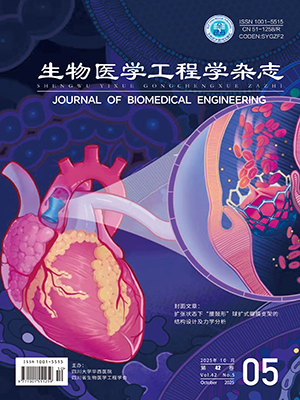| 1. |
Gall M, Li X, Chen X, et al. Computer-aided planning and reconstruction of cranial 3D implants//IEEE engineering in medicine and biology society, Orlando: IEEE, 2016: 1179-1183.
|
| 2. |
Di A L, Di S P, Governi L, et al. A robust and automatic method for the best symmetry plane detection of craniofacial skeletons. Symmetry, 2019, 11(2): 245.
|
| 3. |
Li J, Pepe A, Gsaxner C, et al. A baseline approach for autoimplant: the MICCAI 2020 cranial implant design challenge//Multimodal Learning for Clinical Decision Support and Clinical Image-Based Procedures. Cham: Springer, 2020: 75-84.
|
| 4. |
冀宏, 钱旭升, 周志勇, 等. 基于级联多尺度卷积网络的计算机断层扫描图像肾肿瘤自动分割方法. 生物医学工程学杂志, 2021, 38(4): 722-731.
|
| 5. |
张恒良, 李锵, 关欣. 一种改进的三维双路径脑肿瘤图像分割网络. 光学学报, 2021, 41(3): 60-67.
|
| 6. |
汪豪, 吉邦宁, 何刚, 等. 一种提高直肠癌诊断精度的基于U型网络和残差块的电子计算机断层扫描图像分割算法. 生物医学工程学杂志, 2022, 39(1): 166-174.
|
| 7. |
Wang Bomin, Liu Zhi, Li Yujun, et al. Cranial implant design using a deep learning method with anatomical regularization//Cranial Implant Design Challenge, Cham: Springer, 2020: 85-93.
|
| 8. |
Matzkin F, Newcombe V, Glocker B, et al. Cranial implant design via virtual craniectomy with shape priors//Cranial Implant Design Challenge, Cham: Springer, 2020: 37-46.
|
| 9. |
Jin Yuan, Li Jianning, Egger J. High-resolution cranial implant prediction via patch-wise training. Lecture Notes in Computer Science, Cham: Springer, 2020, 12439: 94-103.
|
| 10. |
Ellis D G, Aizenberg M R. Deep learning using augmentation via registration: 1st place solution to the autoimplant 2020 challenge. Lecture Notes in Computer Science, Cham: Springer, 2020, 12439: 47-55.
|
| 11. |
Ronneberger O, Fischer P, Brox T. U-net: Convolutional networks for biomedical image segmentation. arXiv: 1505.04597, 2015. https: //doi.org/10.48550/arXiv.1505.04597.
|
| 12. |
Li J, Pimentel P, Szengel A, et al. AutoImplant 2020-First MICCAI Challenge on Automatic Cranial Implant Design. IEEE Transactions on Medical Imaging, 2021, 40(9): 2329-2342.
|
| 13. |
Song X, Guo H, Xu X, et al. Cross-modal attention for MRI and ultrasound volume registration//24th International Conference on Medical Image Computing and Computer-Assisted Intervention (MICCAI 2021), Strasbourg: MICCAI, 2021. https: //doi.org/10.1007/978-3-030-87202-1_7.
|
| 14. |
Sinha A, Dolz J. Multi-scale self-guided attention for medical image segmentation. IEEE J Biomed Health Inform, 2021, 25(1): 121-130.
|
| 15. |
Beltagy I, Peters M E, Cohan A. Longformer: the long-document transformer. arXiv: 2004.05150, 2020. https: //doi.org/10.48550/arXiv.2004.05150.
|
| 16. |
Li Shiyang, Jin Xiaoyong, Xuan Yao, et al. Enhancing the locality and breaking the memory bottleneck of transformer on time series forecasting. arXiv: 1907.00235, 2019. https: //doi.org/10.48550/arXiv.1907.00235.
|
| 17. |
Child R, Gray S, Radford A, et al. Generating long sequences with sparse transformers. arXiv: 1904.10509, 2019. https: //doi.org/10.48550/arXiv.1904.10509.
|
| 18. |
Zhou H, Zhang S, Peng J, et al. Informer: Beyond efficient transformer for long sequence time-series forecasting. arXiv: 2012.07436, 2020. https: //doi.org/10.48550/arXiv.2012.07436.
|
| 19. |
Srinivas A, Lin T Y, Parmar N, et al. Bottleneck transformers for visual recognition. arXiv: 2101.11605, 2021. https: //doi.org/10.48550/arXiv.2101.11605.
|
| 20. |
Han Jun, Moraga C. The influence of the sigmoid function parameters on the speed of backpropagation learning. The International Workshop on Artificial Neural Networks: From Natural to Artificial Neural Computation(IWANN 1996), Berlin: Springer, 1995: 195-201.
|
| 21. |
He Kaiming, Zhang Xiangyu, Ren Shaoqing, et al. Deep residual learning for image recognition// 2016 IEEE Conference on Computer Vision and Pattern Recognition (CVPR), Las Vegas: IEEE, 2016. DOI: 10.1109/CVPR.2016.90.
|
| 22. |
Tsai Y H H, Bai Shaojie, Yamada M, et al. Transformer dissection: a unified understanding of transformer's attention via the lens of kernel. arXiv: 1908.11775, 2019. https: //doi.org/10.48550/arXiv.1908.11775.
|
| 23. |
Memisevic R, Zach C, Pollefeys M, et al. Gated softmax classification//Advances in Neural Information Processing Systems, Vancouver: NIPS, 2010, 23: 1603-1611.
|
| 24. |
Kingad A. A method for stochastic optimization. Anon//International Conference on Learning Representations, SanDego: ICLR, 2015.
|
| 25. |
Milletari F, Navab N, Ahmadi S A. V-net: fully convolutional neural networks for volumetric medical image segmentation//2016 fourth international conference on 3D vision, IEEE, 2016: 565-571.
|
| 26. |
Montavon G, Orr G B, Müller K R. Neural networks: tricks of the trade. Springer, 2012. DOI: 10.1007/978-3-642-35289-8.
|
| 27. |
Dice L R. Measures of the amount of ecologic association between species. Ecology, 1945, 26(3): 297-302.
|
| 28. |
Huttenlocher D P, Klanderman G A, Rucklidge W J. Comparing images using the Hausdorff distance. IEEE Transactions on Pattern Analysis and Machine Intelligence, 1993, 15(9): 850-863.
|
| 29. |
Shi Haochen, Chen Xiaojun. Cranial implant design through multiaxial slice inpainting using deep learning//Cranial Implant Design Challenge, Cham: Springer, 2020: 28-36.
|
| 30. |
Kodym O, Španel M, Herout A. Cranial defect reconstruction using cascaded CNN with alignment//Cranial Implant Design Challenge, Cham: Springer, 2020: 56-64.
|
| 31. |
Pimentel P, Szengel A, Ehlke M, et al. Automated virtual reconstruction of large skull defects using statistical shape models and generative adversarial networks//Cranial Implant Design Challenge, Cham: Springer, 2020: 16-27.
|
| 32. |
Mainprize J G, Fishman Z, Hardisty M R. Shape completion by U-Net: an approach to the autoimplant MICCAI cranial implant design challenge//Cranial Implant Design Challenge, Cham: Springer, 2020: 65-76.
|
| 33. |
Bayat A, Shit S, Kilian A, et al. Cranial implant prediction using low-resolution 3D shape completion and high-resolution 2D refinement//Cranial Implant Design Challenge, Cham: Springer, 2020: 77-84.
|




